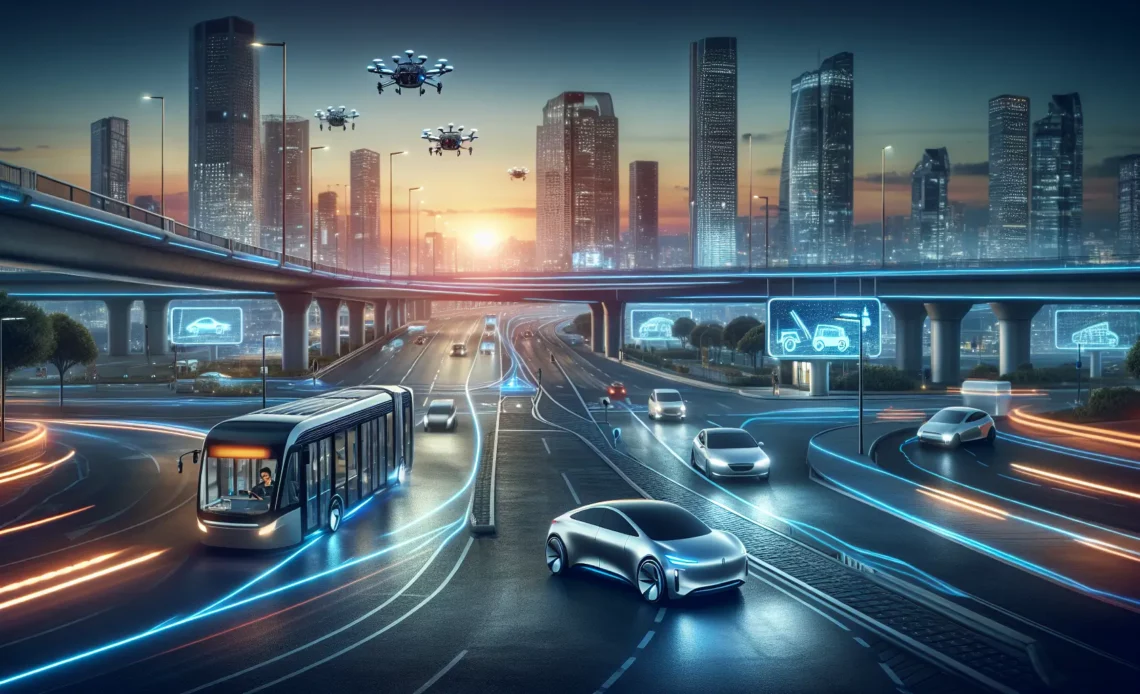In this article, we will discuss about Evolution of Autonomous Vehicles. Autonomous vehicles (AVs), equipped with advanced driver-assistance systems and self-driving technology, represent a transformative leap in transportation. These vehicles promise to enhance mobility, reduce emissions, and even play roles in addressing challenges such as pandemics by enabling isolation and maintaining sterilization. With companies like Google, Uber, Apple, and Zoox at the forefront, the last decade has seen significant advancements in autonomous driving, underpinning the ongoing projects aiming to deploy fully autonomous vehicles on our roads.
Despite the potential pros and cons of autonomous vehicles, their integration into urban landscapes faces hurdles including legal frameworks, public acceptance, ethical dilemmas, and technological evolution. As cities begin to permit the testing and use of self-driving cars on public thoroughfares, understanding these vehicles’ impacts on urban planning, infrastructure, and the environment becomes crucial. This article aims to navigate the complexities and evolutionary journey of autonomous transportation, shedding light on the challenges, opportunities, and the integral role of AI and IoT in the realm of self-driving technology.
The Evolution of Autonomous Vehicles
Milestones in the Development of Autonomous Vehicles
- Early Concepts and Experiments:
- The journey of autonomous vehicles began with Leonardo da Vinci’s design of a self-propelled cart in 1478, highlighting early mechanical automation.
- In 1925, Francis P. Houdina demonstrated a radio-controlled car in New York, pioneering the use of remote control in vehicles.
- The concept was further explored in 1939 by Norman Bel Geddes who introduced semi-autonomous vehicles using electromagnetic fields at the New York World’s Fair.
- Advancements in the Late 20th Century:
- The 1960s and 1970s saw significant advancements with Stanford University and Tsukuba Mechanical Engineering developing vehicles that could navigate autonomously using computer vision and cameras.
- By the 1980s, Ernst Dickmanns had transformed a Mercedes-Benz van into an autonomous vehicle, which could travel autonomously on the autobahn at speeds up to 60 miles per hour using camera and micro-processing technology.
- Modern Era and Technological Integration:
- The 2000s marked a pivotal era with DARPA’s Grand Challenges, which significantly propelled the development of autonomous vehicle technology by encouraging innovation among tech firms and startups.
- In 2010, Stanford’s car “Stanley” demonstrated the potential for autonomous vehicles in urban settings by winning the DARPA Urban Challenge.
- Recent advancements have seen the integration of IoT, 5G, and AI, transitioning vehicles from being human-controlled to highly autonomous systems capable of self-navigation in complex environments.
This timeline underscores the evolutionary strides from basic mechanical inventions to sophisticated systems equipped with cutting-edge technology, illustrating the progressive realization of autonomous vehicles.
Implications for Urban Planning and Infrastructure
Autonomous Vehicles and Urban Space Reclamation
- Transformation of Parking Lots:
- As autonomous vehicles (AVs) become prevalent, the traditional parking lots are envisioned to transform into vibrant community spaces. This could include parks, high-value businesses, or affordable housing developments.
- This shift is expected to free up a substantial amount of urban land, providing opportunities for public amenities and green spaces.
- Redesigning Urban Infrastructure:
- Urban infrastructure will need significant adaptations to accommodate the needs of AVs. This includes the creation of smart roads with embedded sensors and communication devices to facilitate real-time traffic data sharing, which will enhance road safety and efficiency.
- Intelligent traffic systems and dedicated AV lanes are projected to optimize traffic flow and improve overall transportation safety.
- Impact on Urban Planning and Development:
- Buildings and urban development will increasingly focus on facilitating efficient drop-offs and pickups, which may include the redesign of roadways and the installation of advanced communication systems for vehicle-to-infrastructure connectivity.
- Local zoning codes will have to evolve to address new requirements for passenger loading, unloading, and the reduced need for traditional parking spaces.
- Enhancing Public Transportation:
- The integration of AVs into public transportation systems could significantly enhance the efficiency and accessibility of transit services. This includes the potential for self-driving buses and shuttles that offer more flexible and on-demand services, thereby reducing wait times and improving connectivity.
- Safety and Accessibility:
- With the precision driving of AVs, traffic flow is expected to improve, which could lead to a reduction in traffic accidents and enhance safety for all city dwellers.
- Urban planners will need to ensure that the transition to autonomous transportation does not compromise pedestrian and cyclist safety, maintaining livability and accessibility for all residents.
By embracing these changes, cities can not only improve their infrastructure but also enhance the quality of life for their residents, making urban environments more sustainable and efficient.
Environmental and Economic Impact
Autonomous vehicles (AVs) offer significant environmental benefits by potentially reducing car ownership and CO2 emissions due to increased car utilization, which can vary between 5% and 75%. These vehicles enhance the efficiency and safety of transportation flows, saving fuel and time. Additionally, AVs contribute to Environmental, Social, and Governance (ESG) benefits by lowering fuel consumption and emissions. They also pave the way for a greener future by decreasing emissions, increasing safety, and alleviating traffic congestion.
Economic Transformations and Challenges
- Job Market Shifts:
- The rise of AVs could lead to job losses in traditional industries such as trucking and delivery, potentially causing economic instability due to workforce displacement.
- However, new opportunities may emerge in vehicle services, fleet management, and sectors like media and eCommerce, driven by changes in consumer behavior during transit.
- Urban Economic Changes:
- With AVs, cities might see a reduction in income from traffic fines, prompting the introduction of congestion charges or other regulatory measures to maintain revenue levels.
- Local businesses could leverage location-based services to promote themselves to passengers in self-driving vehicles, potentially offsetting losses faced by roadside stores and restaurants.
Environmental Benefits and Risks
- Reduction in Emissions:
- AVs operate more efficiently than conventional vehicles, reducing fuel consumption by 15-20% and significantly cutting down on greenhouse gas emissions.
- The potential for AVs to be powered by clean energy sources further minimizes their environmental impact.
- Impact on Urban Transit and Pollution:
- Deploying AVs in bus and shuttle services, or integrating them into a multimodal, electric urban transportation system, could reduce urban transportation pollution by up to 80% by 2050.
- However, the broad deployment of single-occupancy AVs could increase travel frequency and vehicle size, potentially leading to higher carbon emissions unless managed effectively.
Optimizing Energy and Resource Use
- AI-powered predictive analytics in AVs can optimize route planning, minimize congestion, and improve overall energy efficiency, leading to significant reductions in PM2.5 emission and energy consumption. With further vehicle electrification, these savings could increase dramatically.
Autonomous vehicles intertwine economic and environmental impacts, presenting opportunities for sustainable development and challenges that need strategic management to ensure benefits are maximized while minimizing potential drawbacks.
Challenges and Ethical Considerations
Ethical Dilemmas in Programming Autonomous Vehicles
- Decision-Making in Critical Situations:
- Autonomous vehicles must be programmed to handle no-win scenarios where they must choose between multiple harmful outcomes, such as deciding whether to protect passengers or pedestrians.
- This raises significant ethical questions about how these decisions are prioritized by the algorithms.
- Responsibility for Accidents:
- Determining liability in accidents involving autonomous vehicles is complex, especially when decisions are made by AI.
- Questions about who is held accountable—manufacturers, software developers, or the vehicle itself—are still unresolved.
- Privacy and Data Security:
- Autonomous vehicles rely heavily on collecting and processing personal data for operation, leading to concerns about privacy breaches and data misuse.
- Ensuring robust data protection measures are in place is crucial to protect user privacy.
Technical and Security Challenges
- System Failures and Errors:
- Despite the potential to reduce human error, autonomous vehicles are not immune to system malfunctions that could lead to accidents.
- Ongoing improvements in technology and rigorous testing are essential to minimize these risks.
- Cybersecurity Threats:
- The risk of hacking in autonomous vehicles can lead to severe safety threats, including the potential for fatal accidents.
- Developing advanced cybersecurity measures to safeguard against such threats is imperative.
- Regulatory and Trust Issues:
- Establishing trust with the public regarding the safety and reliability of autonomous vehicles is a significant barrier to widespread adoption.
- The regulatory framework for autonomous vehicles is still developing and varies significantly across jurisdictions, which can hinder their integration into daily transportation.
By addressing these ethical considerations and technical challenges, the development and acceptance of autonomous vehicles can be better managed, ensuring a safer transition to this new era of transportation.
The Role of AI and IoT in Autonomous Transportation
AI and IoT: Pioneers in Autonomous Vehicle Technology
- Core Technologies Behind AVs:
- AI and IoT are foundational in the development of Autonomous Vehicles, enhancing safety and efficiency by reducing human error, which accounts for 90% of automotive crashes.
- The integration of AI helps in refining advanced driver-assistance systems (ADAS) such as automatic braking and lane departure warnings, directly contributing to fewer road incidents.
- Data Handling and Processing:
- Autonomous Vehicles rely on extensive data from sensors and devices to operate safely and efficiently. This data is managed through IoT platforms, which are crucial for the real-time processing and sharing of information.
- The IoT ecosystem for AVs includes layers like perception, network, processing, and application, ensuring that data flows seamlessly across the system to support vehicle operations.
- Connectivity and Smart Navigation:
- The combination of AI and IoT facilitates high-speed, resilient, low-latency connectivity, essential for transforming vehicles into fully smart AVs.
- These technologies enable AVs to merge real-world and digital knowledge, enhancing connectivity and navigation in complex environments.
- Security and Efficiency:
- IoT technology not only supports efficient vehicle operation but also includes a security layer to safeguard against breaches, ensuring the integrity of data and user privacy.
- Edge computing within the IoT framework helps meet the critical requirements of 5G networks, enhancing the speed and accuracy of vehicle communications.
- Innovative Applications in Services:
- AI-driven services in AVs include autonomous delivery options provided by companies like Refraction AI, Starship Technologies, and Kiwibot, showcasing practical applications of this technology in everyday life.
- These advancements promise a transformation in how goods and people are transported, setting the stage for a future where transportation is not only safer but also more environmentally sustainable.
Conclusion
Throughout the exploration of autonomous vehicles (AVs), we have delved into the remarkable evolution from early mechanical innovations to sophisticated systems powered by AI and IoT. Highlighting both the transformative potential and the challenges, our journey underscores the pivotal role AVs may play in shaping future urban landscapes, enhancing safety, and propelling economic and environmental shifts. The discourse on the ethical considerations and technical hurdles reinforces the complexity of seamlessly integrating AVs into our daily lives, illustrating a dynamic frontier at the intersection of technology and societal change.
As we stand on the brink of this automotive revolution, it is crucial to foster a balanced approach that addresses the technical challenges and ethical dilemmas, ensuring that AV technology advances in harmony with human values and environmental sustainability. The potential broad implications of AV adoption call for continued research, thoughtful policy-making, and collaborative efforts among all stakeholders. By doing so, we can endeavor to harness the full potential of autonomous vehicles, crafting a future that leverages technology for greater safety, efficiency, and inclusivity in mobility.
FAQs
What effects will autonomous vehicles have on society?
Autonomous vehicles are anticipated to significantly reduce traffic collisions, deaths, injuries, and associated costs that are currently caused by human error, such as delayed reaction times and various forms of distracted or aggressive driving. Experts in driving safety believe that the full development of driverless technology will lead to a substantial decrease in these incidents.
What are the expectations for the development of autonomous vehicles in the future?
The latest surveys suggest that Level 4 autonomous robo-taxis are expected to be available on a large scale by 2030. Fully autonomous trucking is predicted to become viable sometime between 2028 and 2031. These timelines may be influenced by ongoing technical challenges and the availability of capital for development.
What is the second paragraph’s main focus in the article titled “Autonomous Vehicles”?
The second paragraph of the article “Autonomous Vehicles” aims to explain the intended uses of autonomous vehicles as envisioned by their developers.
In what ways are driverless cars anticipated to transform our daily lives?
Driverless cars are expected to bring about a significant increase in safety on the roads. With the majority of car accidents currently caused by human errors, the introduction of self-driven cars is likely to minimize these errors. Consequently, this is expected to result in fewer car accidents, creating a safer environment for both drivers and pedestrians.



